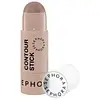What's inside
What's inside
 Key Ingredients
Key Ingredients

 Benefits
Benefits

 Concerns
Concerns

 Ingredients Side-by-side
Ingredients Side-by-side

Water
Skin ConditioningIsononyl Isononanoate
EmollientCyclopentasiloxane
EmollientIsohexadecane
EmollientVinyl Dimethicone/Methicone Silsesquioxane Crosspolymer
Glycerin
HumectantTridecyl Trimellitate
EmollientCetyl PEG/PPG-10/1 Dimethicone
EmulsifyingTrimethylsiloxysilicate
EmollientPropylene Glycol
HumectantBoron Nitride
AbsorbentTrimethoxycaprylylsilane
SmoothingPhenoxyethanol
PreservativePhenyl Trimethicone
Skin ConditioningPEG-10 Dimethicone
Skin ConditioningSorbitan Sesquioleate
EmulsifyingSynthetic Fluorphlogopite
Acrylates/Dimethicone Copolymer
Skin ConditioningDisteardimonium Hectorite
StabilisingTocopheryl Acetate
AntioxidantEthylhexylglycerin
Skin ConditioningSilica Dimethyl Silylate
EmollientTriethoxycaprylylsilane
Silica
AbrasiveMica
Cosmetic ColorantPropylene Carbonate
SolventParfum
MaskingDimethicone
EmollientMethicone
EmollientBenzyl Benzoate
AntimicrobialCI 77891
Cosmetic ColorantCI 77492
Cosmetic ColorantCI 77491
Cosmetic ColorantCI 77499
Cosmetic ColorantWater, Isononyl Isononanoate, Cyclopentasiloxane, Isohexadecane, Vinyl Dimethicone/Methicone Silsesquioxane Crosspolymer, Glycerin, Tridecyl Trimellitate, Cetyl PEG/PPG-10/1 Dimethicone, Trimethylsiloxysilicate, Propylene Glycol, Boron Nitride, Trimethoxycaprylylsilane, Phenoxyethanol, Phenyl Trimethicone, PEG-10 Dimethicone, Sorbitan Sesquioleate, Synthetic Fluorphlogopite, Acrylates/Dimethicone Copolymer, Disteardimonium Hectorite, Tocopheryl Acetate, Ethylhexylglycerin, Silica Dimethyl Silylate, Triethoxycaprylylsilane, Silica, Mica, Propylene Carbonate, Parfum, Dimethicone, Methicone, Benzyl Benzoate, CI 77891, CI 77492, CI 77491, CI 77499
Caprylic/Capric Triglyceride
MaskingIsostearyl Isostearate
EmollientOctyldodecanol
EmollientAluminum Starch Octenylsuccinate
AbsorbentLauroyl Lysine
Skin ConditioningCI 77891
Cosmetic ColorantDimethicone
EmollientDicalcium Phosphate
AbrasiveEuphorbia Cerifera Wax
Copernicia Cerifera Wax
Dimethicone/Vinyl Dimethicone Crosspolymer
Skin ConditioningCI 77499
Cosmetic ColorantOryza Sativa Bran Wax
Skin ConditioningSynthetic Beeswax
Emulsion StabilisingCI 77492
Cosmetic ColorantDisteardimonium Hectorite
StabilisingCI 77491
Cosmetic ColorantHelianthus Annuus Seed Wax
Skin ConditioningSynthetic Wax
AbrasiveTocopherol
AntioxidantPropylene Carbonate
SolventHelianthus Annuus Seed Oil
EmollientChlorella Vulgaris Extract
Skin ConditioningRosmarinus Officinalis Leaf Extract
AntimicrobialCaprylic/Capric Triglyceride, Isostearyl Isostearate, Octyldodecanol, Aluminum Starch Octenylsuccinate, Lauroyl Lysine, CI 77891, Dimethicone, Dicalcium Phosphate, Euphorbia Cerifera Wax, Copernicia Cerifera Wax, Dimethicone/Vinyl Dimethicone Crosspolymer, CI 77499, Oryza Sativa Bran Wax, Synthetic Beeswax, CI 77492, Disteardimonium Hectorite, CI 77491, Helianthus Annuus Seed Wax, Synthetic Wax, Tocopherol, Propylene Carbonate, Helianthus Annuus Seed Oil, Chlorella Vulgaris Extract, Rosmarinus Officinalis Leaf Extract
 Reviews
Reviews

Ingredients Explained
These ingredients are found in both products.
Ingredients higher up in an ingredient list are typically present in a larger amount.
Ci 77491 is also hydrated iron III oxide. It's sole purpose is to give a red/pink hue to products.
Iron III oxides are classified as inorganic chemicals for coloring.
Synthetically created Ci 77491 is considered safer than those naturally found. This is because the synthetically created version may contain less impurities. Iron oxides are generally non-toxic and non-allergenic.
Learn more about CI 77491Ci 77492 is also hydrated iron III oxide. It's sole purpose is to give a yellow hue to products.
Iron III oxides are classified as inorganic chemicals for coloring.
Synthetically created Ci 77492 is considered safer than those naturally found. This is because the synthetically created version may contain less impurities. Iron oxides are generally non-toxic and non-allergenic.
Learn more about CI 77492Ci 77499 is also hydrated iron III oxide. It is created from mixing red and black iron oxides. This helps give shades of darkness to a product.
Iron III oxides are classified as inorganic chemicals for coloring.
Ci 77891 is a white pigment from Titanium dioxide. It is naturally found in minerals such as rutile and ilmenite.
It's main function is to add a white color to cosmetics. It can also be mixed with other colors to create different shades.
Ci 77891 is commonly found in sunscreens due to its ability to block UV rays.
Learn more about CI 77891Dimethicone is a type of synthetic silicone created from natural materials such as quartz.
What it does:
Dimethicone comes in different viscosities:
Depending on the viscosity, dimethicone has different properties.
Ingredients lists don't always show which type is used, so we recommend reaching out to the brand if you have questions about the viscosity.
This ingredient is unlikely to cause irritation because it does not get absorbed into skin. However, people with silicone allergies should be careful about using this ingredient.
Note: Dimethicone may contribute to pilling. This is because it is not oil or water soluble, so pilling may occur when layered with products. When mixed with heavy oils in a formula, the outcome is also quite greasy.
Learn more about DimethiconeDisteardimonium Hectorite comes from the clay mineral named hectorite. It is used to add thickness to a product.
It can also help stabilize a product by helping to disperse other ingredients.
Hectorite is a rare, white clay mineral.
Learn more about Disteardimonium HectoriteThis ingredient is a solvent. It helps dissolve active ingredients and alter the texture of products.
Propylene Carbonate is commonly used in makeup and with clay, such as montmorillonite or bentonite.
Studies show this ingredient to be safe for cosmetics. When it is undiluted, it can cause skin irritation. (It is always diluted in skincare and makeup). This ingredient is water-soluble.
Propylene Carbonate is created from propylene glycol and carbonic acid.
Learn more about Propylene Carbonate